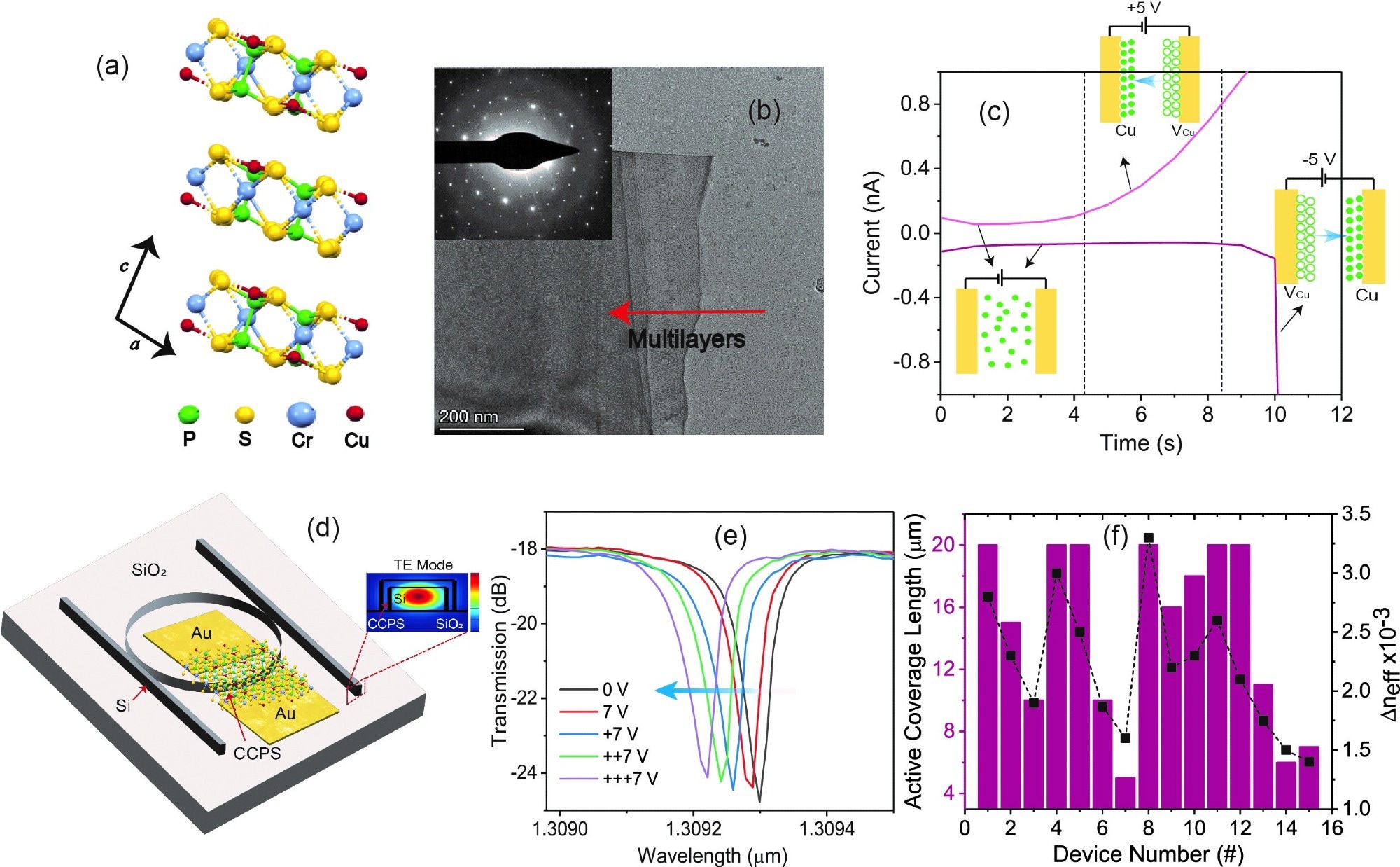In a study published in Light: Science & Applications, Dr. Ghada Dushaq and Professor Mahmoud Rasras, along with colleagues from New York University Abu Dhabi, revealed a new method for active light manipulation using ferroionic 2D CCPS materials.
 a, 3D schematic visualization (ball and stick model) of a-c plane in CCPS structure, b, Transmission electron microscopy (TEM) image along with the selected area diffraction pattern (SADP) of CCPS crystal, c, current- time (I-t) characteristics at ± 5 V along with a schematic representation of Cu distribution, d, 3D schematic representation of the Si microring resonator (MRR) design with integrated CCPS, e, the transmission spectra of MRR at a constant voltage of 7 V as the polling time progressed, across all scans, a consistent blue shift in the resonance wavelengths was observed for all fabricated devices. This blue shift implies an electro-optical modulation of the refractive index of the combined Si/CCPS guiding structure, given that thermal heating typically results in a red shift in the Si-MRR resonance wavelength, additionally, the application of a bias across the device does not affect the extinction ratios and the resonance linewidth, f, coverage length and change in effective refractive index of the 15 tested devices. Image Credit: TranSpread
a, 3D schematic visualization (ball and stick model) of a-c plane in CCPS structure, b, Transmission electron microscopy (TEM) image along with the selected area diffraction pattern (SADP) of CCPS crystal, c, current- time (I-t) characteristics at ± 5 V along with a schematic representation of Cu distribution, d, 3D schematic representation of the Si microring resonator (MRR) design with integrated CCPS, e, the transmission spectra of MRR at a constant voltage of 7 V as the polling time progressed, across all scans, a consistent blue shift in the resonance wavelengths was observed for all fabricated devices. This blue shift implies an electro-optical modulation of the refractive index of the combined Si/CCPS guiding structure, given that thermal heating typically results in a red shift in the Si-MRR resonance wavelength, additionally, the application of a bias across the device does not affect the extinction ratios and the resonance linewidth, f, coverage length and change in effective refractive index of the 15 tested devices. Image Credit: TranSpread
Tunable optical materials (TOMs) are transforming current optoelectronics. In integrated photonics circuits, precise control over the effective refractive index is critical for enabling ground-breaking applications. Two-dimensional materials like Transition Metal Dichalcogenides (TMDs) and graphene have extraordinary optical sensitivities to external stimuli.
However, providing unique modulation over the short-wave infrared (SWIR) area while preserving accurate phase control with low signal loss in a small footprint remains a significant issue.
When these materials are incorporated into SiPh microring resonators, they demonstrate a remarkable capacity to precisely regulate the effective index of refraction without attenuating the optical signal. These integrated devices have minimal optical losses, an excellent modulation efficiency (Vπ. L) of 0.25 V·cm, and a constant blue shift in resonance wavelengths across all devices.
The capacity to actively alter the electro-optic response in 2D CCPS at near-infrared wavelengths opens the door to more efficient and flexible optoelectronic devices with applications in telecommunications, neuromorphic computing, and beyond.
The strong electro-refractive response of these devices is dependent on the electronic characteristics of ferroionic 2D CCPS, which are considerably influenced by their bulk ionic conductivity. This critical characteristic can be accurately controlled by adjusting parameters like as poling time, polarization, and current direction.
Such changes affect the movement of highly mobile copper (Cu) ions, highlighting the interdependence between material characteristics and device performance.
The scientists have summarized the operational principle of their devices:
We have demonstrated a novel approach for actively manipulating light by employing ferroionic 2D CCPS material. Integrated into SiPh microring resonators, these materials showcase an exceptional ability to precisely adjust the effective refractive index without introducing any amplitude chirp. This capability is attributed to the tunable electrical conduction arising from the reversible migration of mobile Cu ions at the metal-semiconductor interface.
The flexibility of the Cu–S bond facilitates Cu ion hopping between intralayer and interlayer sites, and even across the van der Waals (vdW) gap under an electric field. Consequently, optical tuning is achieved through the reversible process of extracting Cu ions from sulfur octahedra across van der Waals gaps and their reintercalation into the layers, a process that is reliably controlled by the applied voltage.
Remarkably, the application of a bias across the device does not affect the extinction ratios and the resonance linewidth. Therefore, the active migration of Cu ions has no impact on the imaginary part of the refractive index. The combined optoelectronic and ionotronic functionalities in the two-terminal CCPS device hold potential for applications, including phased arrays, optical switching, environmental sensing and metrology, optical imaging systems, and neuromorphic systems in light-sensitive artificial synapses.
Journal Reference:
Dushaq., G. et al. (2024) Electro-optic tuning in composite silicon photonics based on ferroionic 2D materials. Light, Science & Applications. doi.org/10.1038/s41377-024-01432-2